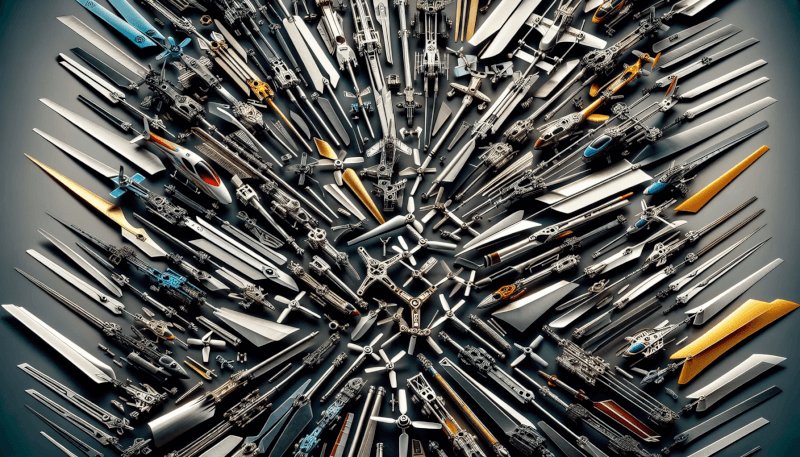Are you passionate about flying remote-controlled helicopters? If so, then understanding the different types of blades for your RC heli is crucial. The right choice of blades can greatly impact the performance and maneuverability of your helicopter. From main rotor blades to tail rotor blades, each type serves a specific purpose. By understanding the characteristics and differences between these blades, you can optimize your RC heli’s flight experience. So, get ready to explore the world of blades and take your remote-controlled flying to new heights!
1. Main Rotor Blades
When it comes to the main rotor blades of your RC helicopter, there are several different types to choose from, each with its own unique characteristics and performance benefits.
1.1 Symmetrical Airfoil Blades
Symmetrical airfoil blades are the most common type of main rotor blades used in RC helicopters. These blades have the same shape on both sides, allowing for equal lift and performance during both positive and negative blade angles. Symmetrical airfoil blades are versatile and suitable for various flying styles, making them an excellent all-around choice for beginners and experienced pilots alike.
1.2 Semi-Symmetrical Airfoil Blades
Semi-symmetrical airfoil blades, as the name suggests, have a slightly asymmetrical shape. This design allows for better lift and performance during positive blade angles while still maintaining decent performance during negative blade angles. Semi-symmetrical blades are often favored by pilots who prioritize aerobatic maneuvers and dynamic flying styles.
1.3 Symmetrical Thin Airfoil Blades
Symmetrical thin airfoil blades are similar to symmetrical airfoil blades but have a thinner profile. This design reduces drag and allows for increased agility and responsiveness during flight. These blades excel in fast and aggressive flying styles, making them a popular choice among advanced pilots looking for maximum performance.
1.4 Flat Bottom Airfoil Blades
Flat bottom airfoil blades feature a flat bottom surface and a curved top surface. This design creates more lift during positive blade angles while sacrificing some performance during negative blade angles. Flat bottom blades are often used by beginner pilots who prioritize stability and ease of control.
1.5 Undercambered Airfoil Blades
Undercambered airfoil blades have a curved shape on both the top and bottom surfaces, creating an inverted airfoil shape. This design provides excellent lift during positive blade angles but may offer less performance during negative blade angles. Undercambered blades are commonly used in scale modeling and slow-flying applications where stable and smooth flight is desired.
2. Tail Rotor Blades
The tail rotor blades of your RC helicopter play a crucial role in providing directional control and stability during flight. Similar to main rotor blades, there are different types of tail rotor blades available, each suited for specific flying styles and requirements.
2.1 Symmetrical Airfoil Blades
Symmetrical airfoil blades are also used in tail rotors to ensure equal performance during positive and negative blade angles. These blades provide balanced control and responsiveness, making them a reliable choice for most RC helicopter enthusiasts.
2.2 Flat Bottom Airfoil Blades
Flat bottom airfoil blades for the tail rotor offer stability and predictable control. They generate ample lift and are favored by beginner pilots who value simplicity and ease of use.
2.3 Wide Chord Airfoil Blades
Wide chord airfoil blades provide increased surface area and lift, making them ideal for larger or heavier RC helicopter models. These blades excel in situations where more torque is required for stability and maneuverability.
2.4 Narrow Chord Airfoil Blades
Narrow chord airfoil blades offer reduced drag and increased agility. These blades are commonly used in lightweight and high-performance RC helicopter models, allowing for quick maneuvers and precise control.

3. Material Composition
The material composition of rotor blades can greatly affect their performance, durability, and overall flight characteristics. Here are some common types of blade materials used in RC helicopters:
3.1 Wood Blades
Wood blades are a traditional choice that provides a good balance between cost and performance. They are relatively lightweight, durable, and offer a smooth flight experience. However, wood blades may be susceptible to moisture damage and require regular maintenance to prevent warping or splitting.
3.2 Carbon Fiber Blades
Carbon fiber blades are renowned for their exceptional strength-to-weight ratio. They are incredibly lightweight, rigid, and provide excellent stability and responsiveness during flight. Carbon fiber blades can withstand high speeds and aggressive maneuvers without sacrificing performance or durability. However, they tend to be more expensive than other materials.
3.3 Plastic Blades
Plastic blades are commonly found in entry-level RC helicopters due to their affordability and ease of manufacturing. While they may not offer the same level of performance as wood or carbon fiber blades, plastic blades are lightweight and can be replaced easily if damaged. They are a cost-effective option for beginners and casual flying.
3.4 Fiberglass Blades
Fiberglass blades combine the benefits of durability and affordability. They provide good strength and resistance to impact, making them suitable for pilots who fly in more challenging conditions or for those who are still perfecting their piloting skills. Fiberglass blades offer a cost-effective alternative to carbon fiber blades without compromising too much on performance.
3.5 Aluminum Blades
Aluminum blades are relatively rare in the world of RC helicopters. Although they are highly durable and can withstand significant impacts, they tend to be heavy, affecting the overall performance and flight characteristics of the helicopter. Aluminum blades are primarily used in industrial or heavy-duty applications where robustness is crucial, but weight is less of a concern.
4. Blade Size and Length
The size and length of the main rotor blades and tail rotor blades can significantly impact the performance and flight characteristics of your RC helicopter. Consider the following factors when selecting blade sizes:
4.1 Main Rotor Blade Size
The main rotor blade size typically depends on the size and weight of your RC helicopter model. Larger blades generate more lift and are suited for bigger helicopters, while smaller blades work well for lighter models. It’s crucial to ensure that the blade size is compatible with the motor and power system to achieve optimal performance and flight stability.
4.2 Tail Rotor Blade Size
Tail rotor blade size is crucial for maintaining proper balance and stability during flight. The size of the tail rotor blades should complement the main rotor blades to avoid any unbalanced forces or unwanted yaw movements. Refer to the manufacturer’s guidelines or consult experienced pilots to determine the appropriate tail rotor blade size for your RC helicopter.
4.3 Effects of Blade Length on Performance
The length of the rotor blades influences various flight characteristics. Longer blades generally produce more lift, resulting in better stability and maneuverability. However, longer blades also tend to increase the overall weight and rotational inertia, which may impact the responsiveness of the helicopter. It’s essential to strike a balance between blade length, weight, and desired flight performance to achieve an optimal flying experience.

5. Blade Pitch
Blade pitch refers to the angle at which the rotor blades bite into the air during rotation. Understanding blade pitch is essential for controlling the lift and maneuverability of your RC helicopter.
5.1 Understanding Blade Pitch
Blade pitch is adjusted using the pitch control mechanism, which allows you to increase or decrease the blade angle. Increasing the blade pitch increases the lift generated, while decreasing the blade pitch decreases lift. Properly adjusting the blade pitch is crucial for achieving stable and controlled flight.
5.2 Collective Pitch
Collective pitch refers to the simultaneous adjustment of all the rotor blades’ pitch angles. Increasing collective pitch increases the overall lift generated by the main rotor, resulting in upward movement. Decreasing the collective pitch reduces lift and enables the helicopter to descend. Mastering the control of collective pitch is vital for achieving stable and controlled climbs and descents.
5.3 Cyclic Pitch
Cyclic pitch refers to the independent adjustment of each rotor blade’s pitch angle as it rotates around the rotor hub. By varying the cyclic pitch, you can control the roll and pitch movements of the helicopter. Adjusting the pitch of specific blades at different points in the rotor rotation cycle creates imbalances in lift, enabling precise control over the helicopter’s movement in different directions.
6. Blade Flexibility
The flexibility of rotor blades can impact the overall flight characteristics and performance of your RC helicopter. Let’s explore the various types of blade flexibility:
6.1 Stiff Blades
Stiff blades offer minimal flex and are generally preferred for high-speed flying and aggressive maneuvers. Stiffer blades provide better stability and precision but may sacrifice some level of responsiveness during low-speed flight or in windy conditions.
6.2 Semi-Flexible Blades
Semi-flexible blades strike a balance between stability and responsiveness. They offer moderate flex, allowing for smoother response to control inputs during both high-speed and low-speed flight. Semi-flexible blades are a popular choice among pilots who engage in a mix of aerobatics and speed flying.
6.3 Flexible Blades
Flexible blades provide maximum flex, optimizing their ability to absorb vibrations and gusts of wind. Higher flexibility enhances stability during low-speed flight and improves overall maneuverability. Flexible blades are commonly used in scale RC helicopters, where stability and smooth flight are prioritized over extreme performance.

7. Blade Tip Shape
The shape of the blade tip can influence the efficiency and flight characteristics of your RC helicopter. Let’s explore the different types of blade tip shapes:
7.1 Pointed Tip
Blades with pointed tips reduce aerodynamic drag and promote efficient airflow around the blade tip. Pointed tip blades are often favored for their increased speed and reduced noise. However, they may be more prone to damage in rough flying conditions due to their sharper shape.
7.2 Rounded Tip
Rounded tip blades offer better stability and efficiency at lower speeds. The rounded shape allows for smoother airflow around the blade tip, reducing turbulence and improving overall flight performance. Rounded tip blades are great for scale-like flying, smooth hovering, and gentle maneuvering.
7.3 Squared Tip
Squared tip blades strike a balance between pointed and rounded tip designs. They offer good efficiency and stability at both high and low speeds. Squared tip blades are versatile and can handle a variety of flying styles, making them a popular choice among pilots who want a balance of performance and stability.
8. Blade Balancing
Blade balancing is a critical aspect of optimizing the performance and lifespan of your RC helicopter. Balanced blades ensure smooth rotation and minimize vibrations, leading to more stable and efficient flight.
8.1 Importance of Blade Balancing
Unbalanced blades can lead to increased wear and tear on the helicopter’s mechanical components and adversely affect flight precision. Balancing the blades reduces excess vibrations, enabling better control and reducing the risk of damage to the helicopter and its electronics. Proper blade balancing is crucial for safe and enjoyable flying.
8.2 Methods for Blade Balancing
There are several methods available to balance rotor blades effectively. One popular approach is using a high-quality blade-balancing tool that allows you to identify and correct any imbalances. By adding or removing small weights on the blades, you can ensure that they are evenly balanced. It’s also essential to regularly check the balance of your blades after any changes or repairs to maintain optimal performance.

9. Blade Tracking
Blade tracking ensures that all rotor blades follow the same path during rotation, resulting in stable and efficient flight. Proper blade tracking minimizes vibrations and prevents undue stress on the helicopter’s components.
9.1 Understanding Blade Tracking
Blade tracking refers to the alignment of the rotor blades in relation to each other. Misaligned blades can cause vibrations and affect the overall stability of the helicopter during flight. Ensuring proper blade tracking is important for smooth and safe operation.
9.2 Adjusting Blade Tracking
To adjust blade tracking, you may need to make small adjustments to the pitch angle of individual blades. Carefully measure the distance between each blade tip and adjust the blade pitch as necessary to achieve uniform tracking. Make incremental adjustments, test the helicopter’s flight, and continue adjusting until the blades are tracking evenly.
10. Blade Maintenance and Replacement
Proper maintenance and timely replacement of rotor blades are crucial for the longevity and safety of your RC helicopter. Regular inspections and upkeep can prevent potential accidents and ensure optimal performance.
10.1 Inspecting Blades for Damage
Regularly inspect the rotor blades for any signs of damage, such as cracks, chips, or warping. Check for loose or damaged blade grips and ensure that the mounting screws are secure. Any signs of wear or damage should prompt immediate replacement to avoid potential flight issues or accidents.
10.2 Cleaning Blades
Cleaning your rotor blades regularly helps maintain their performance and extends their lifespan. Use a soft cloth or sponge and mild soapy water to clean the blades gently. Ensure that the blades are thoroughly dry before reinstalling them on the helicopter. Avoid using abrasive materials or harsh chemicals that could damage the blade surface.
10.3 Replacing Damaged Blades
If a blade is significantly damaged or shows signs of structural issues, it’s crucial to replace it promptly. Continuing to fly with damaged blades can lead to loss of control or more severe damage to the helicopter. Keep spare blades available, and ensure they are compatible with your specific RC helicopter model. Follow the manufacturer’s guidelines for proper installation to guarantee optimal performance and flight safety.
Understanding the different types of rotor blades and their characteristics empowers you to choose the right blades for your RC helicopter. Consider your flying style, experience level, and specific requirements to select blades that will enhance your flying experience and unlock the full potential of your RC heli. Regular maintenance, balancing, and tracking will keep your blades in top condition, ensuring safe and enjoyable flights every time.



